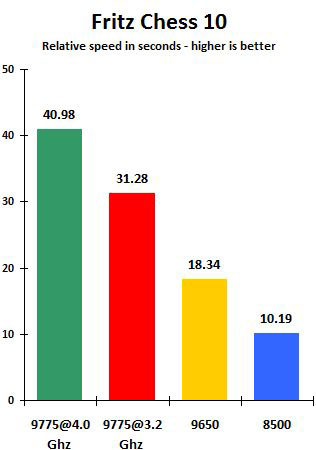|
|
|
|
|
Intel Skulltrail |
|
Join the community - in the OCAU Forums!
|
Desktop Tasks, Power Consumption and Heat
DESKTOP TASKS
We asked WinRAR to compress a 90 MB file, “AVG” to viruscheck a 100 GB hard disk drive with around 90,000 objects, Adobe’s “PDFMaker” to transfer a 36-pages PowerPoint file into a PDF document and “SpyBot” to scan a fully occupied 100 GB hard disk drive for spyware and Trojans. The results are a bit disappointing: Skulltrail did not run any of these tests significantly faster. It is just a few notches better performing than the QX9650 system. This is surprising not only because the QX9650 has “only” 4 cores, but is also running with a 200 MHz lower core frequency. We suspect the FB-DIMM based memory subsystem being the culprit. The negative impact of its higher latency and overheads on performance become evident in a direct comparison between Skulltrail and a system with unbuffered DDR2 memory running applications that do not take advantage of more than 2 or 4 cores. The WinRAR result by the way demonstrates that an application’s capability to run multithreaded does not automatically mean it can take advantage of 8 cores. The difference between running WinRAR with 2 and 4 cores is almost 7% in compression speed. The difference between 4 and 8 cores however is almost zero.

We finally run 2 of the Excel 2007 benchmarks provided by Intel specifically for the evaluation of Skulltrail. Both are real world simulations. We assume of course that Intel has scripted them in a way to show the potential of their dual quadcore platform. The first Excel benchmark is simulating common office calculations. Intel describes it as follows: “A finance worker wants to make some calculations in Excel on a large data set. Calculations including arithmetic operations like addition, subtraction, division, rounding and square root. Also includes common statistical calculations.” Skulltrail is running this benchmark in 2.9 seconds, 47% faster than the QX9650 system. The second Excel 2007 benchmark is running a financial analysis, called “Monte Carlo Simulation”. This is how Intel describes it: “A financial analyst wants to compute the expected prices of stock options using the Black Scholes formula. He needs to do a Monte Carlo simulation to help estimate the correct value.” Skulltrail needs 11.5 seconds to finish this analysis. This is 45% faster than the QX9650 system. Apparently both simulations allow maximum usage of multithreading. An even more pronounced, almost linear scaling effect can be observed with “Fritz Chess 10”. The computational algorithm in this strategy game can be split into as many parallel threads as cores are available. The build-in benchmark shows Skulltrail with a 70% performance advantage versus the QX9650 system and almost 3 times faster than the dual core E8500.
 
POWER CONSUMPTION AND HEAT DISSIPATION
Intel is rating the QX9775 with a thermal design power (TDP) of 150 Watt and a maximum case temperature of 65C. The QX9770 is rated at 132 Watt and 55.5C. We don’t know why these specifications are different, because the QX9775 and QX9770 are thought to be identical besides the pin count. But these ratings are already indicating that Skulltrail is not exactly a power saving system. The wattage monitoring unit we used reads power consumption at the wall plug. The values shown in the “System Power” chart represent therefore total system consumption, including video card, chipset, RAM and peripherals.

When idling Skulltrail consumes 213 Watt. This is around 30% more than the QX9650 system and roughly equivalent to the wattage when the QX9650 is running under load. Under 100% processor load, when 8 instances of Prime95 are running, Skulltrail consumes 410 Watt. This was however only with 1 video card and only 2 memory sockets populated. We guess that a 2-way SLI or CrossFire configuration and 8 FB-DIMMs would push the wattage to 500 Watt. When running Skulltrail under full load, such as with Prime95, core temperatures went eventually up to 65C. The entire system was substantially heating up. The FB-DIMMS as well as the MCH are running hot. Active cooling for both is recommended by Intel, otherwise a strong airflow over the PCB is a must to ensure system stability under full load.
Enjoying this article? Feel free to Digg it!
|
|
Advertisement:
All original content copyright James Rolfe.
All rights reserved. No reproduction allowed without written permission.
Interested in advertising on OCAU? Contact us for info.
|

|


